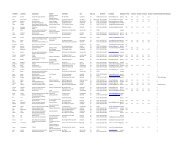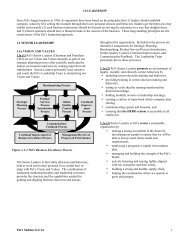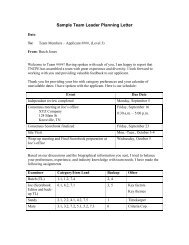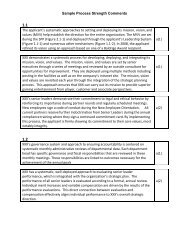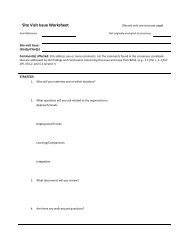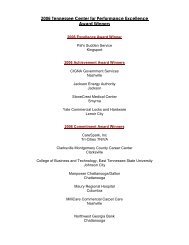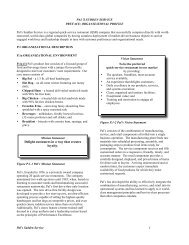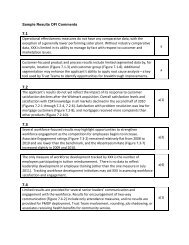Preface: Organization Profile - Tennessee Center for Performance ...
Preface: Organization Profile - Tennessee Center for Performance ...
Preface: Organization Profile - Tennessee Center for Performance ...
Create successful ePaper yourself
Turn your PDF publications into a flip-book with our unique Google optimized e-Paper software.
mission-driven and important to success. MSHA’s<br />
commitment to continually improving quality is seen in the<br />
adoption of the Baldrige National Quality Program Health<br />
Care Criteria <strong>for</strong> Per<strong>for</strong>mance Excellence as the business<br />
model, and in the extensive support <strong>for</strong> quality improvement<br />
through Blueprints and PI processes. This commitment has<br />
led to gains against national benchmarks and the<br />
achievement of state and national recognition <strong>for</strong> the system<br />
(7.6a1). Through its focus on "systemness," MSHA creates<br />
standardized, system-wide processes that provide<br />
consistency and promote efficiency, while allowing facility<br />
leaders the freedom and authority needed to promote<br />
innovation and agility.<br />
Key changes taking place that affect MSHA’s<br />
competitive situation include the systematic development of<br />
the hub and spoke geographic/service area through the<br />
purchase of hospitals in core service areas, and the building<br />
of the new Niswonger Children’s Hospital. Changes<br />
affecting opportunities <strong>for</strong> innovation are the design and<br />
construction of new facilities (ex. Franklin Woods<br />
Community Hospital); this facility is being built to meet<br />
LEED standards and will serve as MSHA’s first “green”<br />
hospital. Changes that create opportunities <strong>for</strong> collaboration<br />
include a recent change in CEO leadership at competitor<br />
WHS. As a result, a landmark collaborative approach to<br />
Quality is being designed by two teams made up of leaders<br />
from MSHA and WHS. The MSHA/WHS Quality team has<br />
jointly produced public service messages in the community<br />
urging individuals to get flu vaccines.<br />
P.2a3 Key Available Sources of Comparative and<br />
Competitive Data Key available sources of comparative<br />
and competitive data from within the healthcare industry and<br />
external to healthcare include: Premier, Inc, Thomson, Fitch,<br />
Standard & Poor’s, NDNQI, National Consumer Research,<br />
Press-Ganey, and Morehead Associates.<br />
Limitations to obtaining comparative and competitive<br />
data are: a lack of consistency in definitions and<br />
calculations among healthcare systems; time lags of up to<br />
a year between data collection and posting of publicly<br />
available healthcare comparisons; the strict<br />
confidentiality of most healthcare related data.<br />
P.2b Strategic Context Strategic challenges have an<br />
influence on MSHA’s ability to maintain high standards of<br />
excellence as defined by the four Pillars of Excellence<br />
(Figure P.1-2) and are addressed in the annual SPP. Primary<br />
challenges are nursing shortages and changes in<br />
reimbursement and debt.<br />
MSHA benefits from many strategic advantages.<br />
Experienced, results-oriented leadership, effective<br />
governance, a commitment to The MSHA Difference, a<br />
focus on “systemness”, and a proactive systematic SPP<br />
create a sense of purpose. The skill and work ethic of<br />
MSHA’s WF, its size, wide range of services, and the hub<br />
and spoke geographic/service area make it a leader in<br />
providing healthcare services in the region it serves.<br />
Relationships – with MSHN affiliates, and other external<br />
<strong>Organization</strong>al <strong>Profile</strong><br />
organizations – keep MSHA abreast of regional needs and<br />
emerging national trends in health care.<br />
Key challenges associated with organizational<br />
sustainability include resource shortages in the areas of<br />
nursing, other human resources, and finance. Key<br />
advantages linked to sustainability are the hub and spoke<br />
geographic/service area and The MSHA Difference.<br />
P.2c Per<strong>for</strong>mance Improvement System In 2002 MSHA<br />
adopted the Baldrige National Quality Program Health Care<br />
Criteria <strong>for</strong> Per<strong>for</strong>mance Excellence as its business model, or<br />
framework <strong>for</strong> organizational improvement. Participation in<br />
both the Baldrige and TNCPE application processes serve as<br />
the approach. By involving multiple levels of the<br />
organization in application development and resolution of<br />
opportunities <strong>for</strong> improvement, the criteria are deployed<br />
through the organization. MSHA evaluates its progress and<br />
learns from it by using the feedback report as input to<br />
strategic planning and systems improvement ef<strong>for</strong>ts, and has<br />
successfully integrated this organization level improvement<br />
approach by encouraging TMs to serve as national and state<br />
examiners. Over 50 TMs have served as examiners at either<br />
the state or national level.<br />
The MSHA Blueprint Process provides the means <strong>for</strong><br />
systematically evaluating the effectiveness of key processes.<br />
Beginning at the system level and cascading down to the<br />
level of each individual TM, leaders create annual<br />
per<strong>for</strong>mance plans called Blueprints. The Blueprint Process<br />
focuses per<strong>for</strong>mance improvement in areas of strategic<br />
importance. It also drives data selection, collection,<br />
aggregation, and analysis, facilitating management by fact,<br />
and per<strong>for</strong>mance measurement.<br />
MSHA’s approach to continual process improvement is<br />
Plan-Do-Check-Act. MSHA improves through the use of<br />
this systematic process and through the use of industry<br />
standard quality tools such as root cause analysis, evidencebased<br />
research, and best practice sharing. Whenever<br />
per<strong>for</strong>mance monitoring and review indicate that a process is<br />
not meeting customer or operational requirements, or when a<br />
benchmark has changed and a higher level of per<strong>for</strong>mance is<br />
required, leaders and TMs use PDCA to develop<br />
improvements. Collaborative Teams, PI Project Teams, and<br />
Individual PI Projects are MSHA’s identified mechanisms to<br />
accomplish system, team or individual improvements. In<br />
2006, MSHA’s approach to process improvement was<br />
enhanced with the addition of the collaborative approach<br />
developed by the Institute <strong>for</strong> Healthcare Improvement<br />
(IHI), which includes small tests of change. Further<br />
enhancements have been made by adding TMs with<br />
extensive Lean experience as Improvement Advisors in the<br />
PI Department.<br />
Mountain States Health Alliance<br />
v




